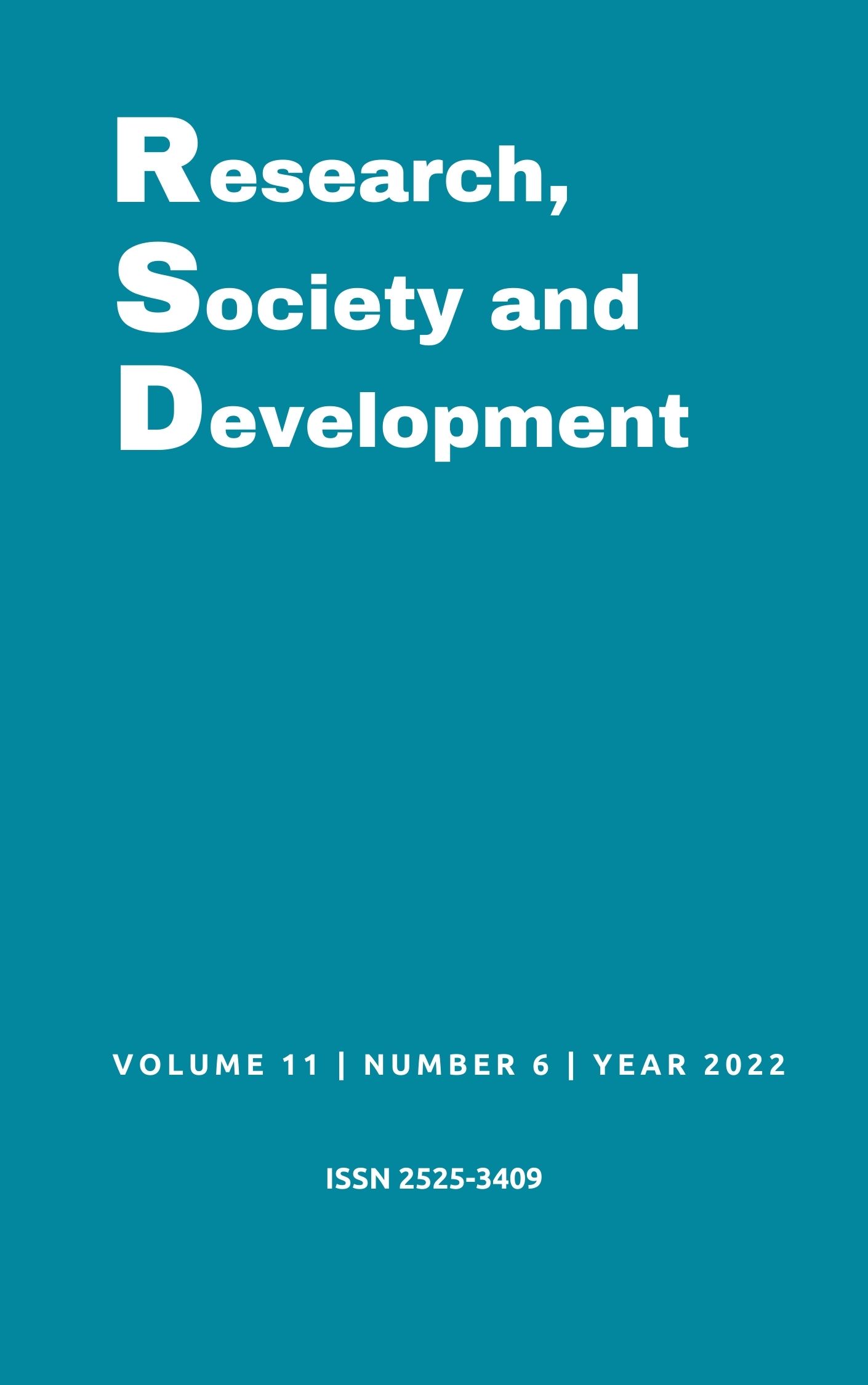Comparação de modelos matemáticos da cinética da secagem de folhas de pennyroyal (Mentha pulegium L.)
DOI:
https://doi.org/10.33448/rsd-v11i6.21924Palavras-chave:
Secagem por convecção; Modelo matemático; Curvas de secagem.Resumo
Mentha pulegium L., popularly known as pennyroyal, has simple leaves that give off a pleasant aroma when crushed. The main objective of this work was to carry out the drying of pennyroyal leaves, to estímate the effective diffusion coefficient through drying kinetics in forced convection, and to, determine the best mathematical model at four different temperatures (40, 50, and 60 ºC) inflow. 1.5 m/s air. Analyzing the drying curves, it was observed that the drying kinetics were strongly influenced by temperature. The thin layer models that best fit the experimental data were Approximate Diffusion, Two Terms, and Logarithmic for the temperatures of 40, 50, and 60 °C, respectively. The evaluation method used the R² (coefficient of determination), RMSE (root-mean-square), and X² (chi-square), and the coefficient of determination parameter remained >0.90. The effective diffusion coefficient decreased 74% with increasing temperature from 40 ºC to 60 ºC and enthalpy and entropy decreased with increasing temperature, while Gibb's free energy increased 5% for each increment of 10 ºC in temperature.
Referências
Ahmed, A., Ayoub, K., Chaima, A. J, Hanaa, L., & Abdelaziz, C. (2018). Effect of drying methods on yield, chemical composition and bioactivities of essential oil obtained from Moroccan Mentha pulegium L. Biocatalysis and Agricultural Biotechnology, 16(October), 638–643. https://doi.org/10.1016/j.bcab.2018.10.016
Chua, K. J., Mujumdar, A. S., Chou, S. K., Hawlader, M. N., & Ho, J. C. (2000). Convective Drying Of Banana, Guava And Potato Pieces : Effect Of Cyclical Variations Of Air Temperature On Drying Kinetics And Color Change. Drying Technology, 18(4–5), 907–936. https://doi.org/10.1080/07373930008917744
Da Silva Morais, S. J., Devilla, I. A., Ferreira, D. A., & Teixeira, I. R. (2013). Mathematical modeling of drying curves and diffusion coefficient of cowpea beans (vigna unguiculata (L.) walp.). Revista Ciencia Agronomica, 44(3), 455–463. https://doi.org/10.1590/S1806-66902013000300006
de Azevêdo, J. C. S., Fujita, A., de Oliveira, E. L., Genovese, M. I., & Correia, R. T. P. (2014). Dried camu-camu (Myrciaria dubia HBK McVaugh) industrial residue: A bioactive-rich Amazonian powder with functional attributes. Food Research International, 62, 934–940. https://doi.org/10.1016/j.foodres.2014.05.018
Deamici, K. M., de Oliveira, L. C., da Rosa, G. S., & de Oliveira, E. G. (2016). Drying kinetics of fermented grape pomace: Determination of moisture effective diffusivity. Brazilian Journal of Agricultural and Environmental Engineering, 20(8), 763–768. https://doi.org/10.1590/1807-1929/agriambi.v20n8p763-768
Fiorentin, L. D., Menon, B. T, Alves, J. A, Barros, S. T. D. de, Pereira, N. C., & Modenes, A. N. (2010). Determination of the drying kinetics and isotherms of orange bagasse. Acta Scientiarum. Technology, 32(2). https://doi.org/10.4025/actascitechnol.v32i2.8242
Henríquez, C., Córdoba, A., Almonacid, S., & Saavedra, J. (2014). Kinetic modeling of phenolic compound degradation during drum-drying of apple peel by-products. Journal of Food Engineering, 143, 146–153. https://doi.org/10.1016/j.jfoodeng.2014.06.037
Jideani, V. A, & Mpotokwana, S. M (2009). Modeling of water absorption of Botswana bambara varieties using Peleg ' s equation. Journal of Food Engineering, 92(2), 182–188. https://doi.org/10.1016/j.jfoodeng.2008.10.040
Leite, A. L. M. P., da Silva, F. S., Porto, A. G., Piasson, D., & dos Santos, P. (2015). Volumetric shrinkage and drying kinetics of Terra variety banana slices. Tropical Agricultural Research, 45(2), 155–162. https://doi.org/10.1590/1983-40632015v4530270
Madamba, P. S, Driscoll, . RH, & Buckle, K. A (1996). The thin-layer drying characteristics of garlic slices. Journal of Food Engineering, 29(1), 75–97. https://doi.org/10.1016/0260-8774(95)00062-3
Mghazli, S., Ouhammou, M., Hidar, N., Lahnine, L., Idlimam, A., & Mahrouz, M. (2017). Drying characteristics and kinetics solar drying of Moroccan rosemary leaves. Renewable Energy, 108, 303–310. https://doi.org/10.1016/j.renene.2017.02.022
Mollaei, S., Ebadi, M., Hazrati, S., Habibi, B., Gholami, F., & Sourestani, M. M. (2020). Essential oil variation and antioxidant capacity of Mentha pulegium populations and their relation to ecological factors. Biochemical Systematics and Ecology, 91(May), 104084. https://doi.org/10.1016/j.bse.2020.104084
Oliveira, G. H. H. et al. (2015). Modeling and thermodynamic properties of strawberry drying Modeling and thermodynamic properties of strawberry drying. 18(4), 314–321. https://doi.org/10.1590/1981-6723.5315
Tavone, L. A da S., Nascimento, K. M, Fachina, Y. J, Madrona, G. S, Bergamasco, R. de C., & Scapim, M. R da S. (2021). Mathematical modeling and effect of thin-layer drying and lyophilization on antioxidant compounds from ultrasonic-assisted extracted muntingia calabura peels. Acta Scientiarum - Agronomy, 43, 1–8. https://doi.org/10.4025/ACTASCIAGRON.V43I1.50301
Yakoubi, R., Megateli, S., Hadj Sadok, T., & Gali, L. (2021). Photoprotective, antioxidant, anticholinesterase activities and phenolic contents of different Algerian Mentha pulegium extracts. Biocatalysis and Agricultural Biotechnology, 34(March), 102038. https://doi.org/10.1016/j.bcab.2021.102038
Downloads
Publicado
Como Citar
Edição
Seção
Licença
Copyright (c) 2022 Wesley da Luz; Gabriela Pinheiro dos Santos; Luciana Alves da Silva; Carla Rosalyn Baca Arévalo; Aroldo Arévalo Pinedo; Carlos Alberto Baca Maldonado; William Renzo Cortez-Vega; Sandriane Pizato; Rosalinda Arévalo Pinedo

Este trabalho está licenciado sob uma licença Creative Commons Attribution 4.0 International License.
Autores que publicam nesta revista concordam com os seguintes termos:
1) Autores mantém os direitos autorais e concedem à revista o direito de primeira publicação, com o trabalho simultaneamente licenciado sob a Licença Creative Commons Attribution que permite o compartilhamento do trabalho com reconhecimento da autoria e publicação inicial nesta revista.
2) Autores têm autorização para assumir contratos adicionais separadamente, para distribuição não-exclusiva da versão do trabalho publicada nesta revista (ex.: publicar em repositório institucional ou como capítulo de livro), com reconhecimento de autoria e publicação inicial nesta revista.
3) Autores têm permissão e são estimulados a publicar e distribuir seu trabalho online (ex.: em repositórios institucionais ou na sua página pessoal) a qualquer ponto antes ou durante o processo editorial, já que isso pode gerar alterações produtivas, bem como aumentar o impacto e a citação do trabalho publicado.

